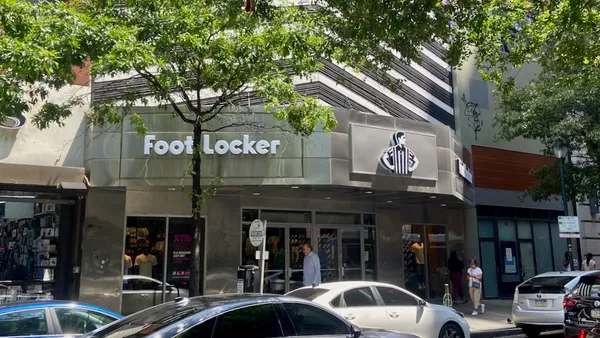Dive Brief:
-
Walmart on Thursday said that its second quarter gross profit margin decreased 11 basis points to 25%, with price reductions in key markets and the growing mix of its e-commerce business hitting the gross margin rate. Total revenue in the quarter rose 2.1% or $2.5 billion to $123.4 billion. Excluding currency, Q2 total revenue rose 2.9% or $3.5 billion to $124.4 billion, according to a company press release.
-
At Walmart U.S., the company said that same-store sales grew 1.8% with traffic growth of 1.3%, the 12th consecutive quarter with positive comp sales. Walmart U.S. net e-commerce sales in the quarter rose 60% and GMV grew 67%, thanks in part to an expanded assortment of more than 67 million SKUs. But gross margin rate in the quarter for the U.S. segment declined 5 basis points, with price reductions and e-commerce costs more than off-setting new deals with vendors, Walmart CFO Brett Biggs told analysts, according to a conference call transcript provided by the company.
-
The company raised its full-year earnings to between $4.30 and $4.40 per share, which includes a range of 90 cents to 98 cents per share for the third quarter, up from its previous full-year guidance of $4.20 to $4.40 per share. The raised guidance includes an expectation that the impact of currency fluctuation will be less, given current exchange rates, the company said.
Dive Insight:
Walmart continues its full-scale effort to grow e-commerce sales — a profound shift from its stalwart brick-and-mortar operations — and this is hitting the bottom line even as the investments appear to be paying off.
"The addition of firms like Moosejaw, Shoebuy, and Bonobos not only give Walmart more of a stake in the digital marketplace but also expand its reach into higher margin categories, niche areas, and more affluent shopper segments," GlobalData Retail Managing Director Neil Saunders said in an email to Retail Dive. "Although these businesses have a somewhat different position than Walmart's core operation, they still benefit from the firm's expertise in logistics and its scale and reach."
As a result of growth at Walmart.com and the string of e-commerce acquisitions that began last year with the $3.3 billion purchase of Jet, Walmart is gaining on Amazon. The market-share battle will continue hurting smaller retailers, noted Moody’s Investors Service lead retail analyst Charlie O’Shea.
"Walmart continued to garner precious market share in the US in Q2, with revenues increasing roughly $2.9 billion year-over-year; however, operating margins fell slightly, reflecting the company's strategy of tactically investing in price to extract that share, as well as the impact of the company’s other investments," O'Shea said in an email to Retail Dive. "[W]e expect this level of performance to continue, along with Walmart’s ongoing efforts to leverage Jet by making tactical pure-play online acquisitions similar to the recent Bonobos deal, and therefore put itself in the solid No. 2 position behind Amazon in most online categories."
Amazon should take notice, Natalie Kotlyar, leader of consultancy BDO’s consumer business practice, told Retail Dive in an email. "Although its brick-and-mortar stores continue to see heavy foot traffic, Walmart anticipates more of its customers will turn to online shopping for convenience, lower prices and a larger selection of products," she said. "Walmart’s interest in acquiring Birchbox underlines its desire to expand its e-commerce presence. The beauty and wellness industries are especially well-positioned for high growth, particularly within the e-commerce and subscription services sectors."
The retail giant's report contains solid comps and online sales growth that "is good to see," says retail analyst Nick Egelanian, president of retail development consultants SiteWorks International, but notably doesn't include a direct mention of e-commerce profits. "The markets will applaud a sustained pattern of increasing traffic and sales across all platforms, which they are delivering," he said in an email to Retail Dive. "My long term outlook for profitability in their commerce operation remains cloudy though."
Similarly, Gordon Haskett analyst Chuck Grom said in a note emailed to Retail Dive that the quarterly report didn't quite deliver. "We think the comp/digital contribution needed to be a touch stronger (to be fair) to drive fresh money into the name," he said, though he also raised his share price estimates in light of Walmart's moat being "one of the strongest in retail."
The retail giant’s success is especially evident in its U.S. grocery segment, though that is being threatened by the expansion of no-frills German chains that have devastated the company’s grocery business in the U.K. and by Amazon’s planned acquisition of Whole Foods.
"The grocery business has really strengthened as food categories delivered the strongest quarterly comp sales performance in five years," CEO Doug McMillon told analysts. The majority of the retailer’s e-commerce growth was organic through Walmart.com, including online grocery, "which is growing quickly," Biggs added.
It’s one of Walmart’s "particular areas of success" and bodes well for the increasing competition brought by the German players in the U.S., according to Saunders. "Our data show continued gains in customer share, even in areas where discounters like Aldi have expanded," he wrote. "The reason for this is mostly, although not completely, down to Walmart's continued investment in everyday low prices. As the grocery sector enters one of its toughest phases, we believe that Walmart is well positioned to make further gains. It is one of the few firms that have the firepower to cope with the push towards compressed prices and margins."













